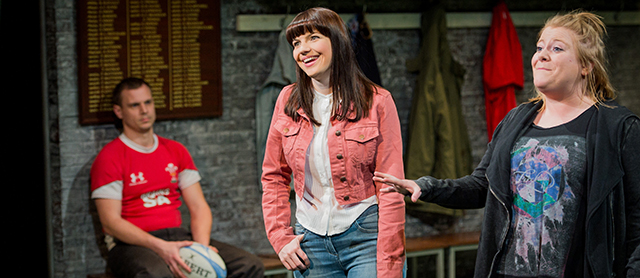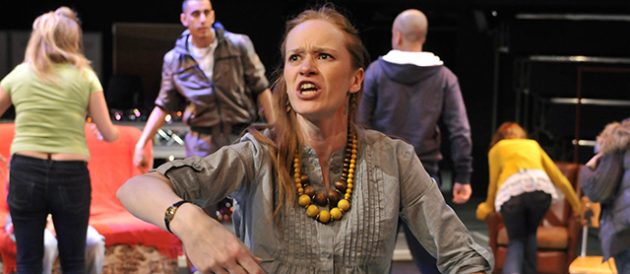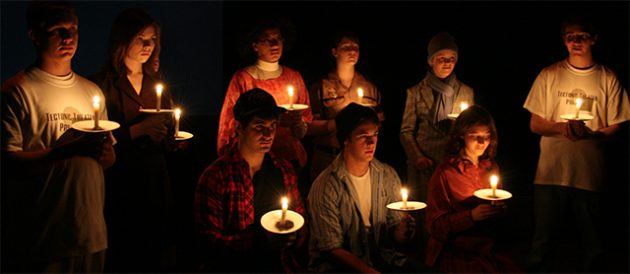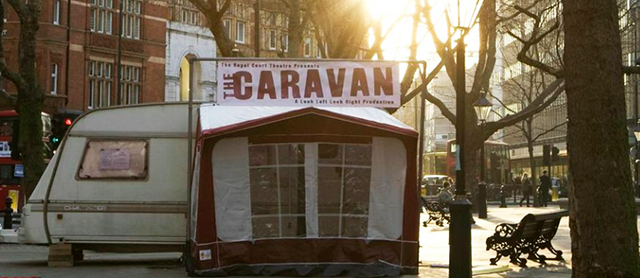SECTIONS:
- What is Verbatim Theatre?
- For example… 40 years of verbatim plays
- Practical guide to making verbatim theatre
WHAT IS VERBATIM THEATRE?

Crouch, Touch, Pause, Engage by Robin Soans
Verbatim theatre is theatre made from real people’s words. A form of documentary theatre, it allows theatre makers to explore events and themes through the words of people at the heart of them, and was hugely influential in the revival of political theatre at the beginning of the 21st Century.
Verbatim theatre is usually created from the transcription of interviews with people who are connected to a common event or subject. The interviews are then edited into a performance text. Often, actors are involved in conducting this research and feeding it back to the writer, director or company making the piece.
This research provides the both the spoken material for the play (in the case of the musical London Road, the sung material); also a play’s characters. Characters in a verbatim play often represent a specific, real person. They may be identifiable, or their name and characteristics may be changed. Sometimes, characters may be amalgamations of more than one person.
Actors in verbatim plays might attempt to mimic their counterparts exactly, or decide to represent them less literally. Indeed, actors with the company Recorded Delivery went as far as wearing earphones during performances, listen to recordings of interviewees while simultaneously portraying them in order to recreate speech patterns and hesitations precisely. Whether mimicking or not, actors often speak of a loyalty to the people they represent, and a wish to do right by them.
(These choices are particularly noticeable if an actor is playing a well-known person: In Crouch, Touch, Pause, Engage, six very different actors, male and female, took turns to play rugby player Gareth Thomas without attempting to mimic him; the cast of Talking To Terrorists gave recognisible approximations of Mo Mowlam, Terry Wait and Norman Tebbit; while in The Permanent Way, Lloyd Hutchinson offered a comically accurate impression of Richard Branson.)
Although verbatim theatre employs techniques similar to journalism, its objectives are different. It tends to tell stories that are not urgent or immediate in the way that journalistic stories are, but with more perspective. There will be a focus on finding the theatricality, and the characters, in the story. Verbatim work allows a range of voices and perspectives to be heard and represented in a vividly immediate way.
Verbatim theatre can look at the whole picture, or at least a wide range of view-points, without needing to find a specific ‘angle’ – although of course, the author of a verbatim play edits, censors, and rearranges just as the editor of a documentary would: David Hare conceded of his play The Permanent Way (about British Rail’s privatization), “I’m all over it like a rash”. His play Stuff Happens (about the build up to the Iraq War) openly combined verbatim dialogue with fictional, speculative scenes.
If theatre can unearth and share real stories that are untold elsewhere, it can also turn an ongoing, messy event into a comprehensible overview. It brings the strands together, helping its audience evaluate events that may be too big, too close, too recent. An extreme, literal example of this was the Tricycle Theatre’s series of “tribunal plays” which reproduced and condensed public inquiries, such as those into the deaths of David Kelly and Stephen Lawrence, into single, manageable evenings of theatre.
Don’t miss our Verbatim Theatre INSET Day on 22 October!
FOR EXAMPLE… 40 YEARS OF VERBATIM PLAYS

Out of joint and Octagon Theatre Bolton’s production of Mixed Up North by Robin Soans
Here are some well-known and less well known examples of verbatim plays from 1976 to the present, including work by key companies including Out of Joint, Recorded Delivery and the Tricycle Theatre, and practioners such as Robin Soans, Alecky Blythe and Anna Deavere Smith.
Robin Soans is one of the most prominent verbatim writers. His collaborations with Out of Joint began with A State Affair (2000), about a Bradford estate devastated by a heroin epidemic.
Soans’ other plays with Out of Joint include Talking To Terrorists (2005) based on interviews with former terrorists, victims and politicians; Mixed Up North (2009) about a youth theatre in Burnley which was set up to bring together white and Asian youths following the so-called race riots; and Crouch Touch Pause Engage (2015) which told the story of gay Welsh rugby icon Gareth Thomas, and his home town Bridgend which was itself the subject of media intrusion following a number of suicides.
The Permanent Way (2003) by David Hare looked at the 1990s privatization of Britain’s railways, building its narrative from the four major train crashes that followed. A co-production by Out of Joint and the National Theatre it premiered in the great railway city of York. Buy the script.
Home (2013) by Nadia Fall explored homelessness among young people via interviews with residents of a London hostel. It premiered at the National Theatre’s temporary space The Shed.

The Laramie Project
The Laramie Project (2000) by Moisés Kaufman and the Tectonic Theatre Project was about the town of Laramie’s reactions to the abduction and murder of gay student Matthew Shepard, and to the media’s depiction of them as red-necked white trash. It was adapted as a film (2002) with a starry cast.
The Exonerated (2002) by Jessica Blank and Erik Jensen depicted wrongly-convicted survivors of death row.
In the Tricycle Theatre’s Justifying War (2003), writer Richard Norton Taylor and director Nicholas Kent condensed the Hutton inquiry into the death of UN weapons inspector David Kelly into 2 hours of theatre. Other tribunal plays at the Tricycle covered the Stephen Lawrence inquiry, the Scott Arms to Iraq Inquiry, the Bloody Sunday Inquiry, the Srebrenica UN War Crimes Tribunal, and the Nuremburg Trials. Read an article on verbatim theatre by Richard Norton Taylor here.
And at the Landor Theatre in 2009, Kieron Barry’s Stockwell: The inquest into the death of Jean Charles de Menezes delved into the circumstances of Jean Charles de Menezes, using only edited transcripts from the investigation.
Also at the Tricycle, Guantamo: Honor Bound To Defend Freedom (2004) was based on letters and interviews with prisoners and their lawyers and relatives.
Anna Deavere Smith’s one-woman play Twilight: Los Angeles, 1992 (1994) told the story of the 1992 Los Angeles riots through a series of monologues based on interviews. Her previous show Flies in the Mirror covered the 1991 Crown Heights riots in Brooklyn.
Performers with Alecky Blythe’s Recorded Delivery company replicated all the ums and ahs of the people that Blythe interviewed for their productions, which include Cruising (2006) about pensioners looking for love. Her musical with Adam Cork about the murders of five women in Ipswich, London Road (2011, later filmed) incorporated such speech patterns into its music while The Girlfriend Experience was based on interviews with women working in a brothel.
Der Spiegel commissioned Klaus Pohl’s Waiting Room Germany (1994) to test the mood of Germany after reunification using a wide range of personal testimonies of gain and loss.
Playwright Owen McCafferty turned to 100 year transcripts of survivors’ accounts for Titanic (2012)

The Caravan by Look Left Look Right
The Caravan (2007) by Look Left Look Right told the stories of those worst affected by the 2007 floods and was performed in its own temporary accommodation: a caravan parked outside the Royal Court Theatre and elsewhere.
Australian writer Paul Brown’s play Aftershocks (1991) documented the effects of the 1989 earthquake which destroyed the Newcastle Workers’ Club through the recollections of those affected.
Yesterday’s News (1976) was about war in Angola. It was produced by Max Stafford-Clark and William Gaskill’s Joint Stock Theatre Group. As Gaskill told it, they were at a loss for what play to do next, and decided to look through the newspapers for a story. The play was written from the company’s interviews with Angolan mercenaries.
Commissioned by Max Stafford-Clark, Falkland Sound (1983) by Louise Page gave voice to many people touched by the Falkland War, including a woman who ran a support group for sailors’ wives in Plymouth, and a journalist who had been embedded with the invading forces on the ship The Canberra. A shell-shocked Scots Guard talked to the actor-researchers, as did a teacher from the Islands, and an Argentinan woman resident in London who listened in horror to the rolling news of the war.
CREATING VERBATIM THEATRE: A PRACTICAL GUIDE
Don’t miss our Verbatim Theatre INSET Day on 22 October!
Choose a topic
It is not about deciding on characters or a plot, but about agreeing on an area of interest. Perhaps you are drawn to a particular location (a park, a care home, a shopping centre); a way of life (an occupation, an obsession or a lifestyle); an event (a riot, a county show, a sports event). It could even be something more abstract like an emotion.
Preparation
Make a list of people who might inform the subject from as many areas and viewpoints as possible. So think both about people who are central to the idea or issue, and people who are on the edge. For example, if your topic was a rave then you might need to talk to local residents, police and parents as well as people who would attend the rave, and the rave organisers.
Think about how you will contact the people on the list and, when you have some agreed participants, decide who interview whom. You may find it useful to practice interviewing each other before going into the field (see interview skills below).
Schedule a time when the interviewers will report back to the group – try to make this as soon after the interview as possible so that the details are still fresh in your mind.
Interviews
Interviews are often best conducted in small groups of two or three. As a small group you will benefit from sharing observations about the interview, as each person may recall different elements. Interviewing with a companion or two can also give you confidence and a sense of security.
Interview skills
Make a list of key questions that you feel you need to ask. This helps to direct the interview and keep it on track. But be flexible and responsive, and ready to follow a course of questions that you may not have anticipated.
Be polite, and don’t be judgmental. Somebody has given up their time to talk to you, and your interviewees will respond best if they feel able to talk openly without criticism.
Be honest. Explain why you want to talk to them and what the project is about. Be clear about whether the interview will be or can be anonymous: in 22 some cases you may be interviewing someone whose identity is key to the project, or somebody well known; in many cases, the specific identity is not important, so consider how that anonymity might be preserved.
It is helpful to make written notes, or alternatively to record an interview, to remind yourself of details later. Ask permission from the interviewee and again be clear what the notes or recording will be for.
As an interviewer your job is to initiate questions, and prompt when necessary. It is a conversation but it is not a discussion. Don’t be drawn into a debate or argument. Your own views aren’t the subject here, and you will get the best material by not alienating your interviewee.
Let them talk. Bring an interview back on track if required, and pursue further details, but no one likes to be constantly interrupted. Often, great material and details will emerge once the interviewee has warmed up and talked for a while.
It’s obvious, but really listen.
Mentally record the person’s physical and emotional demeanour. Try to remember particular gestures or phrases, as these will help you when it comes to relating the interview back to the group.
Reporting back
Report back from your interview to the rest of the company. A good way of doing this is the “hot seat”. Instead of merely relating what you’ve learnt, you “become” the interviewee that you met, and the rest of the group ask you questions.
Reporting back skills
Before starting the ‘hot seat’ interview, set the scene for the rest of the group. Where did the interview take place? What did the person look like? And tell the group some of the questions that they need to ask, in order to share the answers that you were given.
Try to adopt the manner of the person. The way they sat, the tone of their voice, gestures that they used. It’s not about the quality of your acting but about trying to give an impression of the person you interviewed. Have your notes of the interview ready to refer to, but try not to depend on them too much.
Sometimes it may be easier for two people to role-play together, so that they can both draw from their memories and notes. This can also increase the energy level of the role-play.
It is the responsibility of the rest of the group to ‘keep the ball in the air’. If there is a silence, they should ask another question.
If a question is asked that was not covered in the original interview then improvise a response, but keep this to a minimum.
At the end of the hot seat, tell the group anything that was not covered but that you feel is important. And if you had to improvise any responses, make clear what these were.
Style and structure of the play
Once you have collected a number of characters (you may decide you need to interview someone again), the next stage is to decide whose stories and accounts to include in the play. Think about what stories represent the idea of the play, that tell you something about the subject. You might need to say goodbye to characters and stories even though they’re interesting, and indeed to characters that you might like to play as an actor.
You might decide to hear each story in isolation – a series of monologues. But you don’t need to deliver each story in one go. You can break them into installments and overlap them with other characters’ stories, perhaps choosing each segment by theme to give different perspectives on one part of the subject of the play, or grouping your characters by real or thematic relationships between them. Breaking down the text into short phrases can create a montage effect.
Verbatim exercise
In this exercise, the group will create a short ensemble piece of verbatim theatre. Work in groups of four or five. The first task is for the group to find someone to interview. Find someone in the vicinity who is not known well to the actors: perhaps a theatre technician or, in a school, a teacher or caretaker or other member of staff.
Set a chair for the interviewee facing the interviewers. The group spends ten minutes asking this person any questions they would like to, listening carefully and trying to remember as much detail as possible. Pay attention to the interviewee’s mannerisms, posture and tones of voice too. Once the time is up, thank the interviewee and let them go.
Now the group will recreate the interview. One player remains as an interviewer to ask questions. The remainder communally play the interviewee. They can respond together to questions where appropriate, or chip details individually as they are remembered. Replicate the gestures and tones of voice too.
Notice how some elements will have been particularly memorable, and everyone will be able to take part in recreating those moments, giving extra volume to reflect their significance. By responding as a group the actors can paint a full a picture of the interviewee. It is also an interesting way to look at how each of us notices different aspects of a persona.
Once you have completed this exercise, think about what kind of details you found most interesting and why. Often, small details will stand out: we relate to the minutiae of stories and remember them. This is a useful way of giving colour when you are devising a text.

 Search
Search
